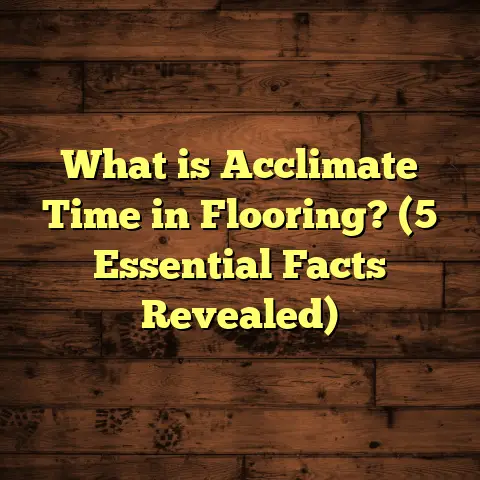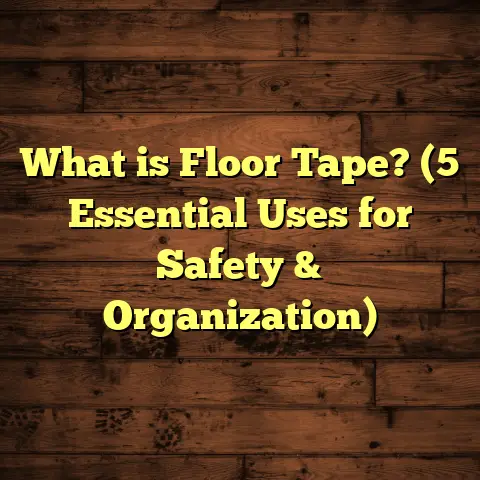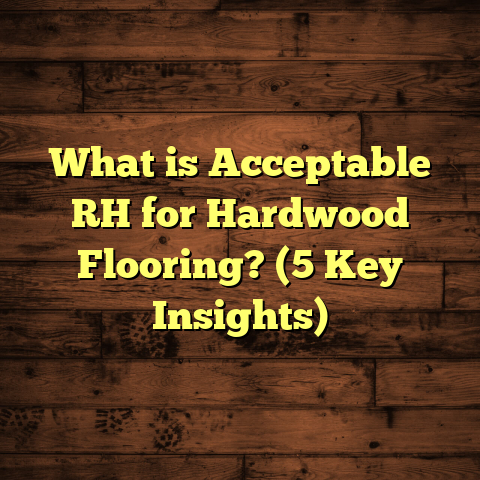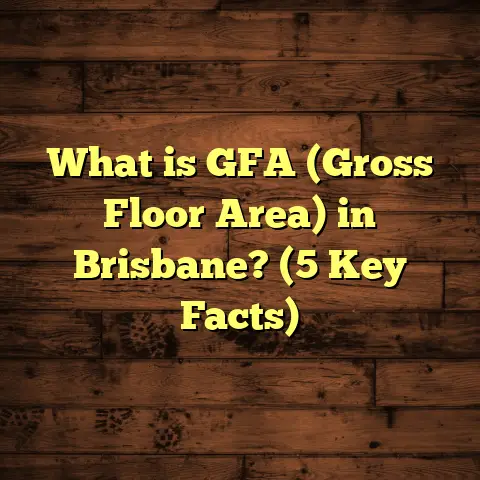What is Luxury Vinyl Flooring Made Of? (5 Key Components Explained)
What is Luxury Vinyl Flooring Made Of?
When I first started working in flooring, I often heard people dismiss luxury vinyl flooring (LVF) as “just cheap vinyl.” That statement always got under my skin because from my hands-on experience, LVF is far from cheap or simple. It’s a smartly engineered product designed to combine beauty, durability, and functionality in ways that traditional flooring sometimes can’t match.
So, what is luxury vinyl flooring really made of? At its core, LVF is a multi-layered synthetic flooring product composed primarily of polyvinyl chloride (PVC) and other specialized materials. Each layer plays a vital role in making the floor look beautiful while standing up to everyday wear and tear.
I want to take you through the five key components of luxury vinyl flooring that make it such a versatile and popular choice for both homes and commercial spaces. Along the way, I’ll share some personal stories, technical details, and data-backed insights that can help you understand why LVF deserves your serious consideration.
The Five Key Components of Luxury Vinyl Flooring
1. Wear Layer – The Protective Armor
Let’s start at the very top—the wear layer. This thin but mighty layer is what protects your floor from scratches, stains, scuffs, and fading caused by sunlight. It’s essentially the floor’s first line of defense.
What is it made of?
The wear layer is usually made from clear urethane coatings combined with aluminum oxide particles. These materials are highly resistant to abrasion and chemical damage. Aluminum oxide is the same abrasive used in sandpaper, so you can imagine how tough it is!
Thickness Matters
Wear layers typically range from 6 mils (thousandths of an inch) to 30 mils for commercial-grade flooring. When I’m advising homeowners, I usually suggest a wear layer of at least 12 mils for residential use. Why? Because it strikes a balance between durability and cost.
I remember a client who bought an LVF with only a 6-mil wear layer for their busy kitchen. Within just two years, they started noticing scratches and dull patches. We replaced it with a 20-mil wear layer product, which has held up beautifully for over five years now.
How is the wear layer made?
Manufacturers apply the urethane coating over the printed film using advanced techniques like UV curing. This process uses ultraviolet light to harden the coating instantly—sort of like how nail gel cures under a UV lamp—but on an industrial scale.
Technical Specs & Testing
Wear layers are tested using ASTM F410 abrasion resistance standards. A higher abrasion resistance rating means better durability under heavy foot traffic. Commercial spaces with lots of footfall often require wear layers of 20 mils or more.
2. Print Film Layer – The Visual Heart
If the wear layer protects the floor, the print film layer is what gives it personality. This is the decorative part that mimics natural materials like hardwood, stone, or ceramic tile.
How does it work?
The print film is a PVC sheet printed with high-resolution images using UV-resistant inks to ensure colors don’t fade. The printing technology used here has evolved significantly over the past decade.
I’ve seen early luxury vinyl floors where the wood grain looked flat and artificial. Now, thanks to four to six layers of digital printing combined with embossing techniques, LVF can create textures that feel like real wood grain under your feet.
Personal Story:
Once, I installed LVF in a boutique hotel lobby where the client insisted on having the floor look exactly like reclaimed barn wood. We sourced a product with a print film so realistic that guests couldn’t believe it wasn’t actual wood. The texture was embossed right on top of the print layer to give a tactile feel—something I recommend whenever possible if you want authenticity.
Technical Details:
- The print film typically ranges from 0.1mm to 0.3mm thick.
- It uses UV-cured inks that resist fading from sunlight exposure.
- Advanced printers can replicate natural color variations and wood knots with millions of color shades.
3. Core Layer – The Structural Backbone
The core layer gives luxury vinyl flooring its thickness and stability. Think of it as the skeleton that supports everything else.
There are two main types of cores you’ll encounter:
- Flexible Vinyl Core: Made mainly from layers of PVC and plasticizers; thinner and more flexible but less rigid.
- Rigid Core: Made from Stone Plastic Composite (SPC) or Wood Plastic Composite (WPC), rigid cores provide more durability and stability.
Stone Plastic Composite (SPC)
SPC cores consist of limestone powder mixed with PVC resin. This combination creates a dense, rigid core that resists dents and warping much better than flexible vinyl.
During one commercial office installation, we chose SPC core LVF because the subfloor was uneven. The rigidity helped minimize movement and maintained a flat surface without needing expensive subfloor leveling.
Wood Plastic Composite (WPC)
WPC cores include wood fibers combined with PVC, giving them slight softness underfoot while maintaining strength.
Thickness & Density:
Core thickness typically ranges from 3mm to 8mm or more depending on product grade. SPC cores are about 40% denser than flexible vinyl cores, which explains their enhanced durability.
Manufacturing Process:
The core is created through extrusion or compression molding:
- Raw materials including PVC powder, stabilizers, plasticizers, and fillers are mixed.
- The mixture is heated and pressed into sheets.
- Sheets are cut into planks or tiles ready for lamination with other layers.
4. Backing Layer – The Support Base
The backing layer sits at the bottom of the flooring plank and provides crucial support functions like moisture protection, sound damping, and cushioning.
Some LVF products come with an attached underlayment in this layer—usually foam or cork—which adds comfort underfoot and reduces noise transmission.
In my experience installing basement floors where moisture is always a concern, this backing layer acts as an effective vapor barrier. It protects against subfloor moisture that could otherwise cause warping or mold growth.
Sound Reduction Data:
Integrated backing layers can reduce noise by up to 20 decibels compared to floors without this feature—a significant improvement if you live in multi-story homes or apartments.
Some premium LVF brands use closed-cell foam or cork backing which offers better insulation properties too.
5. Adhesive Layer (Optional) – The Bonding Agent
Not all luxury vinyl floors have this layer, but many peel-and-stick or glue-down LVFs include an adhesive backing.
This adhesive is usually pressure-sensitive acrylic or urethane-based glue designed for strong bonding to subfloors like concrete or plywood.
In one project where we had to install LVF in a busy retail store within just two days, using adhesive-backed planks sped up installation dramatically by eliminating messy glue spreading steps.
For heavy commercial traffic zones or equipment movement areas, this adhesive helps prevent plank shifting or lifting over time.
Deeper Look at Manufacturing Processes
Understanding how these layers come together physically helps appreciate the craftsmanship behind luxury vinyl flooring.
Calendering
This process rolls heated PVC compounds into thin sheets using large rollers called calenders. It’s how manufacturers create uniform thickness sheets for both the core and print film layers before assembly.
Lamination
Multiple layers—wear layer, print film, core—are laminated together under heat and pressure using specialized presses. This fuses them into a single plank or tile with strong interlayer bonds.
Embossing
To add texture matching the visual print layer (wood grain, stone pores), embossing rollers press patterns onto the surface while still warm.
Cutting & Profiling
Planks are precision-cut using CNC machines that also create locking profiles like click-lock edges for easy installation without glue in floating floors.
Quality Control
Each plank undergoes rigorous inspections for thickness consistency, color accuracy, surface defects, and locking mechanism fit before packaging.
Technical Specifications You Should Know
| Feature | Typical Range / Value | Notes |
|---|---|---|
| Wear Layer Thickness | 6 mils – 30 mils | Higher values = more durability |
| Print Film Thickness | 0.1mm – 0.3mm | High-res printed with UV-cured inks |
| Core Thickness | 3mm – 8mm | SPC cores denser than flexible vinyl |
| Plank Width | 4″ – 9″ | Wider planks mimic hardwood look |
| Plank Length | 36″ – 60″ | Longer planks reduce seams |
| Abrasion Resistance | ASTM F410 Class I-IV | Class III+ recommended for residential |
| Sound Reduction | Up to 20 dB with integrated backing | Improves comfort and noise control |
| Water Resistance | Waterproof (with SPC/WPC cores) | Suitable for kitchens, bathrooms |
Real-World Case Studies
Case Study 1: Family Home Kitchen Renovation
The Johnson family wanted new flooring in their kitchen that looked like natural hardwood but could handle spills and heavy foot traffic from their two kids and dog.
We chose an LVF product with:
- 20-mil urethane wear layer for durability
- High-res oak print film with embossed texture
- SPC rigid core for stability on uneven subfloor
- Integrated foam backing for sound absorption
After two years of use, they reported minimal scratches and easy cleanup after spills—exactly what they hoped for!
Case Study 2: Boutique Hotel Lobby
A boutique hotel needed flooring that looked luxurious but was budget-friendly and durable against high foot traffic.
We installed LVF with:
- Thick wear layer (25 mils)
- Photorealistic stone print film
- WPC core for slight softness underfoot
- Cork backing for noise reduction
Hotel management said guests frequently complimented how “real” the floor looked compared to typical vinyl tiles they’d seen elsewhere.
My Personal Insights & Tips
Over years of installing luxury vinyl floors in various environments—from cozy homes to busy commercial settings—I’ve learned a few things worth sharing:
- Always check wear layer thickness first. It’s the biggest determinant of longevity.
- Rigid cores are best if subfloor isn’t perfectly flat. They help prevent dents and creaks.
- Opt for embossed textures if you want authenticity. Smooth surfaces look flat no matter how good the print.
- Don’t skimp on backing layers in multi-level homes. They improve comfort and reduce noise transfer.
- Consider adhesive-backed LVF for quick installs in commercial spaces.
Why Understanding LVF Composition Matters
Knowing what goes into your luxury vinyl flooring means you can make smarter buying decisions tailored to your lifestyle.
Are you a pet owner worried about scratches? Look for thick wear layers with aluminum oxide coatings.
Do you want something waterproof for bathrooms? SPC core LVF combined with moisture-resistant backing will serve you well.
Trying to stay on budget but need style? Flexible core LVF with decent wear layers can offer great value without sacrificing looks too much.
Final Thoughts on Luxury Vinyl Flooring Components
Luxury vinyl flooring is an engineered product designed to deliver performance and style through its carefully crafted layers:
- Wear Layer – Protects against daily abuse.
- Print Film Layer – Provides realistic aesthetics.
- Core Layer – Adds structural integrity.
- Backing Layer – Supports comfort and moisture resistance.
- Adhesive Layer (Optional) – Enhances installation stability.
Each component plays a unique role that when combined creates a floor suited for modern living spaces that demand beauty without compromise on durability or maintenance ease.
If you’re thinking about installing luxury vinyl flooring yourself or hiring professionals, understanding these components helps you ask the right questions—and get exactly what you need for your space’s demands.
Need help picking out products or want installation advice? Just ask—I’m here to help!





